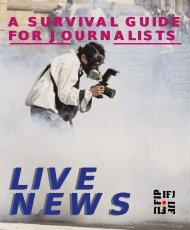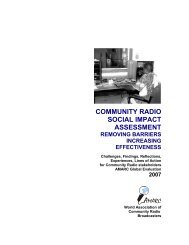Promoting social cohesion: the role of community media - amarc
Promoting social cohesion: the role of community media - amarc
Promoting social cohesion: the role of community media - amarc
- No tags were found...
You also want an ePaper? Increase the reach of your titles
YUMPU automatically turns print PDFs into web optimized ePapers that Google loves.
The promotion <strong>of</strong> economicdevelopment and <strong>of</strong> <strong>social</strong>enterprisesUSAScribe Video Center, PhiladelphiaThe promotion <strong>of</strong> employmentUKRadio Regen, ManchesterThe provision <strong>of</strong> opportunities for<strong>the</strong> gaining <strong>of</strong> work experienceUKDesi Radio, SouthallThe promotion <strong>of</strong> <strong>social</strong> inclusionNor<strong>the</strong>rn IrelandDown FMThe promotion <strong>of</strong> cultural andlinguistic diversityCanadaRadio Centreville, MontrealThe promotion <strong>of</strong> civicparticipation and volunteeringCubaCocodrilo, Sou<strong>the</strong>rn Cuba“In <strong>the</strong> politically conservative climate <strong>of</strong> <strong>the</strong> early 1990s [...] founders became increasinglywary <strong>of</strong> supporting art that might prove controversial […] Although <strong>media</strong> artsorganisations now place more emphasis on earned income and diverse funding sources, <strong>the</strong>ycontinue to be vital cultural centres providing communities access to both <strong>media</strong> facilities anda full range <strong>of</strong> <strong>media</strong> cultural experiences […] The Scribe Video Center reaches out tocommunities, including people <strong>of</strong> colour, women, senior citizens, and teens, that traditionallyhave not had access to video training or production facilities, and provides <strong>the</strong>m with tools forstorytelling. In addition to production and scriptwriting workshops, Scribe <strong>of</strong>fers artists’services such as fiscal sponsorship, equipment rental, and editing facilities. Ongoingprograms include Community Visions, a video production program for <strong>community</strong>organisations; Street Movies, a free outdoor neighbourhood-based screening series; and <strong>the</strong>Producers’ Forum screening and lecture series <strong>of</strong> visiting artists and <strong>media</strong> activists.Additionally, Scribe produces <strong>the</strong> Documentary History Project for Youth, an annualproduction workshop for middle and high school students.” (Johnson & Menichelli 2007:8).“Three previous volunteers are now in work experience with <strong>the</strong> BBC; one has paidemployment with a local commercial station; two have paid employment with a local artcentre; one has obtained a place on a fast-track training course for Black and Asian artsadministrators; six, previously unemployed for more than a year, have unskilled jobs; onehas enrolled on an Access course leading to a degree. Apart from ’volunteer progression’ […]most volunteers ’feel more part <strong>of</strong> <strong>the</strong>ir <strong>community</strong> as a result <strong>of</strong> <strong>the</strong>ir work with us.’”(Everitt 2003b: 71).Desi Radio is a radio for <strong>the</strong> Punjabi <strong>community</strong> <strong>of</strong> west London […] aiming to encourage,promote and develop a sense <strong>of</strong> <strong>community</strong> among Punjabi people and to raise awareness <strong>of</strong>Punjabi language and culture […] Around 75 people volunteer per year.Desi also <strong>of</strong>fers about 12 work experience placements a year to young people who are atschool or college. The station finds that <strong>the</strong> involvement <strong>of</strong> young people is very beneficial to<strong>the</strong> station and feels that <strong>of</strong>fering work experience in <strong>the</strong> <strong>media</strong> to young people is part <strong>of</strong> <strong>the</strong>station’s remit..[and] reports that volunteering can have a very powerful effect on individualswho get involved. It has had life-changing consequences for some people, as <strong>the</strong>ir confidenceand self-esteem has dramatically increased. For some volunteers, getting out <strong>of</strong> <strong>the</strong> house andlearning English are big steps that may lead to paid employment. Desi has had some successin assisting people into work in <strong>the</strong> <strong>media</strong> sector. Six volunteers have gone on to jobs incommercial radio stations and one now works at ITV (CM Solutions (2005b:22).The station “is situated within a College <strong>of</strong> Fur<strong>the</strong>r and Higher Education which drawstoge<strong>the</strong>r a group <strong>of</strong> 14-15 year olds from local schools each Friday […] referred to <strong>the</strong> Collegebecause <strong>the</strong>y are regarded as presenting challenging attitudes or behavioural patterns whichare never<strong>the</strong>less thought likely to respond to learning opportunities outside <strong>the</strong> normalschool environment. The students are from mixed religious backgrounds and quite <strong>of</strong>ten <strong>the</strong>College sessions represent <strong>the</strong> first occasion on which <strong>the</strong>y have been required to work closelywith people with differing religious beliefs. ..[<strong>the</strong>y] work in groups to script, produce anddeliver 10 minute audio cassettes within <strong>the</strong> radio studio. Quite <strong>of</strong>ten <strong>the</strong> youngsters will beso impressed with this taster session that <strong>the</strong>y subsequently enrol for full and part-time BTECcourses at <strong>the</strong> College” (Department for Culture, Media and Sport 2006:12).“Programming […] reflects <strong>the</strong> cultural mosaic <strong>of</strong> <strong>the</strong> city [...] It is made up <strong>of</strong> broadcastsproduced and hosted by members <strong>of</strong> <strong>the</strong> cultural communities using <strong>the</strong>ir own languages.They participate in <strong>the</strong> <strong>social</strong> life <strong>of</strong> Quebec by communicating <strong>the</strong>ir own culture, and at <strong>the</strong>same time help <strong>the</strong>ir compatriots become more aware <strong>of</strong> Quebec and Canadian current eventsand culture. Listeners benefit from information in <strong>the</strong>ir own languages about <strong>the</strong> new <strong>social</strong>environment to which <strong>the</strong>y must adapt, and <strong>the</strong>y conserve <strong>the</strong>ir cultural origins.Communication between newly arrived ethnic groups and long-established cultural groupspromotes, in many ways, a mutual understanding <strong>of</strong> habits, moral values, and <strong>social</strong> andphilosophical currents <strong>of</strong> thought. And it clearly allows a more harmonious coexistence <strong>of</strong>individuals, despite <strong>the</strong>ir differences.” (Girard 1992:52).“Owned and operated by <strong>the</strong> local <strong>community</strong>, <strong>the</strong> Cocodrilo CMC was established as a way toconnect this remote rural <strong>community</strong>, to <strong>the</strong> mainland <strong>of</strong> Cuba and beyond. The radio was setup in 2002 with support from UNESCO; telecentre facilities were added a year later. The CMCfocuses primarily on <strong>social</strong> issues and produces radio programmes on general health, HIV/AIDS, and education. There is also a strong focus on <strong>the</strong> environment [...] The CMC hasbecome an important local medium for <strong>community</strong> forums, discussion and debate. Ingeneral, <strong>the</strong> centre has been a major boost to participatory <strong>community</strong> organising anddevelopment. Computer facilities are used primarily for training and for computer-assistedlearning in <strong>the</strong> local school. Before <strong>the</strong> establishment <strong>of</strong> <strong>the</strong> CMC, residents felt disconnectedfrom <strong>the</strong> activities <strong>of</strong> Cuba and <strong>the</strong> region. Though a small <strong>community</strong>, forums were difficultto coordinate. The multi<strong>media</strong> centre brought a greater sense <strong>of</strong> <strong>social</strong> inclusion andparticipation to <strong>the</strong> residents.” (UNESCO 2005:96).a. Centrelink is <strong>the</strong> federal government’s statutory agency assisting people to become self-sufficient and supporting those in need.Important for <strong>the</strong> delivery <strong>of</strong><strong>social</strong> gain are <strong>the</strong> collaborativepartnerships which stations andprojects form with organisations <strong>of</strong>civil society. These may range from<strong>the</strong> basic use <strong>of</strong> airtime by an organisationto publicise its activities,through programme slots takenover by a local organisation, to <strong>the</strong>4. Characteristics <strong>of</strong> third sector <strong>media</strong> 21
















